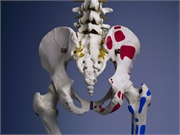Exposure to PM2.5, black carbon linked to lower bone mineral content in adults living in South India
FRIDAY, Jan. 3, 2020 (HealthDay News) — Exposure to ambient particulate matter air pollution with an aerodynamic diameter <2.5 µm (PM2.5) and black carbon (BC) is associated with lower bone mineral content (BMC) in adults, according to a study published online Jan. 3 in JAMA Network Open.
Otavio T. Ranzani, M.D., Ph.D., from the Barcelona Institute for Global Health in Spain, and colleagues quantified the association between ambient and household air pollution and bone mass in a cross-sectional analysis involving 3,717 adults from 28 villages in peri-urban South India.
The researchers found that PM2.5 was associated with lower BMC in the spine (mean difference, −0.57 g [95 percent confidence interval (CI), −1.06 to −0.07] per 3 µg/m³ increase in PM2.5) and hip (mean difference, −0.13 g [95 percent CI, −0.3 to 0.03 g]) in fully adjusted models. After adjustment for confounders, exposure to PM2.5 was associated with lower bone mineral density in the spine (mean difference, −0.011 g/cm² [95 percent CI, −0.021 to 0]) and hip (mean difference, −0.004 g/cm² [95 percent CI, −0.008 to 0.001]). Exposure to BC was also associated with lower BMC in the spine and hip, although the confidence intervals were wider. No association was seen between biomass fuel and spine BMC.
“Further studies in areas with high levels of air pollution from outdoor and household sources, investigating bone mass but also the incidence of osteoporotic fractures, are needed to better quantify the current and future burden of air pollution on bone health,” the authors write.
Copyright © 2020 HealthDay. All rights reserved.








